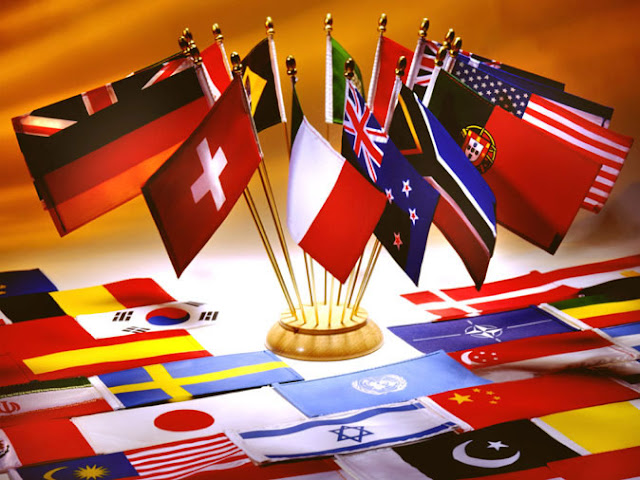 What are the world's world most spoken language?
What are the world's world most spoken language?This question is a very interesting one that has a rather complicated answer. Estimates of how many people speak a language are quite general and can vary considerably. For example, English estimates vary from 275 to 450 million, Spanish from 150 to over 300 million, Hindi from 150 to 350 million, and Russian from 150 to 180 million.
To further complicate matters, the definition of “speaker” can be vague. Some surveys of languages give information on native speakers only. Others count both native speakers and secondary speakers (those who use the language regularly or primarily even though it is not their native language).
Lastly, it is important to consider not only the population (number) of language speakers, but also the geographic distribution of these languages. Some languages have relatively large populations of native speakers but are used almost exclusively in a few countries. On the other hand, other languages have relatively small populations of native speakers but are used in many different countries as an official or national language.
The Summer Institute for Linguistics (SIL) Ethnologue Survey (1999) lists the following as the top languages by population:
(number of native speakers in parentheses)
1. Chinese* (937,132,000)
2. Spanish (332,000,000)
3. English (322,000,000)
4. Bengali (189,000,000)
5. Hindi/Urdu (182,000,000)
6. Arabic* (174,950,000)
7. Portuguese (170,000,000)
8. Russian (170,000,000)
9. Japanese (125,000,000)
10. German (98,000,000)
11. French* (79,572,000)
* The totals given for Chinese, Arabic, and French include more than one SIL variety.
The following list is from Dr. Bernard Comrie’s article for the Encarta Encyclopedia (1998):
(number of native speakers in parentheses)
1. Mandarin Chinese (836 million)
2. Hindi (333 million)
3. Spanish (332 million)
4. English (322 million)
5. Bengali (189 million)
6. Arabic (186 million)
7. Russian (170 million)
8. Portuguese (170 million)
9. Japanese (125 million)
10. German (98 million)
11. French (72 million)
The following list is from George Weber’s article “Top Languages: The World’s 10 Most Influential Languages” in Language Today (Vol. 2, Dec 1997):
(number of native speakers in parentheses)
1. Mandarin Chinese (1.1 billion)
2. English (330 million)
3. Spanish (300 million)
4. Hindi/Urdu (250 million)
5. Arabic (200 million)
6. Bengali (185 million)
7. Portuguese (160 million)
8. Russian (160 million)
9. Japanese (125 million)
10. German (100 million)
11. Punjabi (90 million)
12. Javanese (80 million)
13. French (75 million)
However, in terms of secondary speakers, Weber submits the following list:
(number of speakers in parentheses)
1. French (190 million)
2. English (150 million)
3. Russian (125 million)
4. Portuguese (28 million)
5. Arabic (21 million)
6. Spanish (20 million)
7. Chinese (20 million)
8. German (9 million)
9. Japanese (8 million)
Thus, if you add the secondary speaker populations to the primary speaker populations, you get the following (and I believe more accurate) list:
(number of speakers in parentheses)
1. Mandarin Chinese (1.12 billion)
2. English (480 million)
3. Spanish (320 million)
4. Russian (285 million)
5. French (265 million)
6. Hindi/Urdu (250 million)
7. Arabic (221 million)
8. Portuguese (188 million)
9. Bengali (185 million)
10. Japanese (133 million)
11. German (109 million)
The following is a list of these languages in terms of the number of countries where each is spoken. The number that follows is the total number of countries that use that language (from Weber, 1997):
1. English (115)
2. French (35)
3. Arabic (24)
4. Spanish (20)
5. Russian (16)
6. German (9)
7. Mandarin (5)
8. Portuguese (5)
9. Hindi/Urdu (2)
10. Bengali (1)
11. Japanese (1)
The number of countries includes core countries (where the language has full legal or official status), outer core countries (where the language has some legal or official status and is an influential minority language, such as English in India or French in Algeria), and fringe countries (where the language has no legal status, but is an influential minority language in trade, tourism, and the preferred foreign language of the young, such as English in Japan or French in Romania).
After weighing six factors (number of primary speakers, number of secondary speakers, number and population of countries where used, number of major fields using the language internationally, economic power of countries using the languages, and socio-literary prestige), Weber compiled the following list of the world's ten most influential languages:
(number of points given in parentheses)
1. English (37)
2. French (23)
3. Spanish (20)
4. Russian (16)
5. Arabic (14)
6. Chinese (13)
7. German (12)
8. Japanese (10)
9. Portuguese (10)
10. Hindi/Urdu (9)
source


















0 comments:
Post a Comment